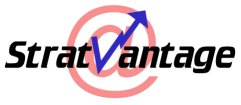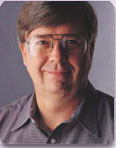|


Be on the wave or under it™
The News – 03/14/03
|
In this Issue:
|
Recommended Reading
|
|
|
I realize this is the only
newsletter you’ll ever need, but if you want more in-depth
detail, check out:
Stan Hustad’s
The Coaching Connection
Management Signature's
The Express Read
|
Nanotechnology and Surfing the Tsunami
Alert SNS Reader John Gehring points out that the Nanotechnology
Research and Development Act of 2003 mentioned in the previous
SNS is (affectionately? derisively?) known as the NeRD Act. How
appropriate. Well, as I indicated last issue, it’s more than nerds
that need to be concerned with the bill, and with the rising tide
of nanotechnology.
Nanotechnology refers to the manipulation of substances smaller
than 100 nanometers, or billionths of a meter. That’s approximately
100,000 times smaller than a human hair. Many nanotechnologies
directly act upon atoms and molecules, and one of the most promising
creates structures known as nanotubes.
Nanotubes are made up of carbon atoms that form a circular molecule.
You may remember a story from high school science about how a
famous chemist, drowsing before a fire, had a dream of a snake
eating its tale. He awoke with a start and realized that if carbon
made a circular molecule it would explain his puzzling experimental
findings. The story’s not quite as sexy as Archimedes running
naked from his bath through the streets of Athens screaming, “Eureka,
I have found it!” but it’s a bit more metaphysical.
Anyway, scientists can take these circular carbon molecules and
create hollow tubes out of them: nanotubes. These things turn
out to be 100 times stronger than steel and able to be combined
into things like cable and fabric. In fact a company in Japan
is readying a fabric making plant that will reinforce the cloth
it makes with nanotubes. (Gunze Sangyo,
Japan's biggest men's underwear maker in March unveiled
a new process to make fabric using nanotubes – in March 2001!)
Imagine if your jeans never wore out. Think what would happen
to the fashion industry. (Now, discuss amongst yourselves.)
The foundations of more than one industry will be shaken to their
core by nanotechnology, and soon — by the end of this decade.
Think of the possibilities if you could make cables 100 times
thinner. Or if you could make super thick cables of unimaginable
strength. How about impossibly round ball bearings grown automagically
from raw materials?
In recent nano news (nanoo-nanoo?), Intel announced last September
they are working with Harvard and other universities on silicon
nanowires and carbon nanotubes, two experimental structures made
up of, respectively, self-assembling silicon and carbon atoms.
After 2010, one of these technologies could begin to replace standard
transistors and over time become the building block of chips.
Frankly I think it will be a lot sooner. One result by mid-decade,
according to Intel's chief technical officer, Pat Gelsinger, will
be that Intel will integrate entire radios onto ordinary silicon
chips. As a result, wireless communications will essentially become
free.
Think of the changes that will bring as millions of devices start
chirping to one another, scheduling maintenance, ordering replacement
parts, and doing the grocery shopping for you. The song of the
devices reminds me of the harmoniums, creatures from Kurt Vonnegut’s
Sirens of Titan. There were two types: one sang, “Here
I am, here I am, here I am;” the other sang “So glad you are,
so glad you are, so glad you are.” Vonnegut was prescient. Soon
our everyday items will be gaily singing similar songs to one
another.
When such technology reaches an even smaller scale, it will also
be easy to create sensor networks (like the smart dust project
mentioned in a previous
SNS), where pint-sized “motes” spread over a large area measure
seismic activity, temperature, pressure or other factors. Such
networks are being explored today. Researchers are using sensors
to monitor how atmospheric changes can alter animal behavior at
the Great Duck Island Environmental Preserve in Maine. Typically,
researchers have to make these observations directly, which can
disturb animals.
To make the teeny chips for these new teeny devices, Intel is
experimenting with atomic layer deposition, making chips by piling
single layers of atoms on top of each other. The resulting structures
rely on chemical properties to self-assemble.
All this manufacturing experimentation is just a small corner
of the nanotechnology explosion. Even such primitive techniques
as causing an aluminum wire to explode by means of a blast of
electrical energy can create nanoscale products. In this case,
Argonide
Nanomaterials
uses the resulting teeny fibers to make an excellent water
filter.
Jack Uldrich, former Deputy Director of the Minnesota Department
of Strategic and Long Range Planning and author of an upcoming
book on nanotechnology, gave a talk in February at the Dakota
County (MN) Technical College. His topic was nanotechnology and
how Minnesota could capture investment dollars and train workers
in the new technology.
Take a look at the implications of the venue at which Uldrich
spoke. DCTC is a small two year technical school more used to
turning out machine shop operators and networking technicians
than super-duper-high-tech technicians. Yet they’ve got the vision
to start preparing for the nano future. Way to go! Something’s
definitely going on. Even Forbes has a nanotechnology newsletter.
Uldrich forecasted a $1 trillion nanotechnology market by 2015
and listed just a few of the ways nanotech will revolutionize
manufacturing:
- Creating continuously cleaning food processing
equipment without the use of corrosive or toxic chemicals
- Producing non-invasive medical devices or drugs
for diagnosis, monitoring and administration
- Creating lighter and stronger materials
- Dramatically increasing data communication and
storage capacity
Let’s take a look at just one example of this last point, one
which shows the convergence of genomics with nanotechnology. Researchers
at the Weizmann Institute in Israel are using DNA to solve complex
computing tasks. Think of it: a trillion of these DNA computing
devices can fit into a drop of water and a spoonful holds 15-thousand-trillion
computers. Not only that, these scientists are using the DNA itself
to provide the power to do the calculations by breaking the bonds
between the two strands of the DNA helix, releasing enough energy
to power the computation.
Is your mind blown yet? Well, just look at the way scientists
are now starting to think
about computing:
Think of DNA as software, and enzymes
as hardware. Put them together in a test tube. The way in which
these molecules undergo chemical reactions with each other allows
simple operations to be performed as a byproduct of the reactions.
The scientists tell the devices what to do by controlling the
composition of the DNA software molecules. It's a completely different
approach to pushing electrons around a dry circuit in a conventional
computer.
Once the input, software, and hardware
molecules are mixed in a solution, it operates to completion without
intervention.
As Keanu Reeves would say, “Whoa!”
When the researchers get this far out (see the following item
on transporting), it’s hard to argue with Raymond Kurzweil’s contention
that the rate of change is changing at an exponential rate. As
I told
a college writing class at the College of St. Scholastica recently,
only change masters will survive the coming tsunami of technical
innovation. And only those who master new forms of communication
have a prayer of surfing that wave.
Be on the wave or under it™!
News.com
Briefly Noted
- Shameless Self-Promotion Dept.:
I was quoted extensively on future tech in a recent issue of
the Minneapolis magazine, Upsize, which is aimed at growing
businesses.
A couple issues ago I debuted SNS Begware, an opportunity for
you, gentle reader, to express your appreciation by tipping
your server via PayPal. See the sidebar for more info. Total
in the kitty so far: $35.00. (Thanks, Ken!)
I’ve reworked the Opinion
section, adding a Prediction
Tracking page to track the various predictions I’ve made,
and also added a Stuff
I Said page with some quotes of things I said a decade or
so ago on the Net.
I repurposed and adapted an article about the wireless service
known as Short Messaging Service (SMS) for the Reside newsletter.
It’s entitled, Wherever
they go, there you are and it points out how marketers
can use – carefully – this new way to contact their customers.
I’m featured in Manyworlds’ Thought
Leader Showcase, which lists a few of the white papers I’ve
done. I’ve also added their fancy icon to the StratVantage site.
Finally, the CTOMentor wireless white paper, You Can Take
It with You: Business Applications of Personal Wireless Devices,
is available at ITPapers.
- The Traveling Wi-Fi:
I wrote before
about cruising for wireless LANs – also known as war driving
– and finding a signal hundreds of feet away through concrete
at the Mall of America. Well, I’ve recently found a few other
unsecured wireless LANs (besides the one run by my neighbor
down the street, who is unconvinced there’s any reason to implement
security). The other day, on the way back from picking up my
son for Spring Break, I found a wireless LAN while stopped at
a traffic light in Mankato, MN (he was driving; I practice safe
computing). I got connected and downloaded several pieces of
email before the light changed. I also caught another signal
on the way out of town, but we were moving too fast to attach.
Then, back in St. Louis Park, MN, I briefly caught a whiff of
another WLAN while driving down Cedar Lake Road.
But I found the more interesting WLANs while sitting at gate
C21 on the United concourse at O’Hare airport in Chicago, waiting
for my flight. I picked up two baggage handler WLANs named BAGSCANUAORD,
one on channel 1 and one on channel 6. Earlier in Minneapolis,
I had watched the baggage handlers scan each baggage tag with
a handheld scanner before loading them on the plane. I guess
they use a Wi-Fi network to communicate to look up and match
travelers and their bags.
In addition to these two WLANs, I found another named rsp on
channel 6. Unfortunately (or fortunately, depending on how you
look at it), although I was able to attach to all three networks
and get an IP address, none of the three provided a connection
to Internet services. Although I couldn’t see any other Windows
computers on the networks, doesn’t it make you feel a little
less secure knowing these WLANs are unsecured? This is despite
plenty of press about similar unsecured WLANs at O’Hare and
other airports. Come on people! It takes two seconds to take
a few basic security measures.
- Teleportation Is Real, If You’re a Quantum Bit:
OK, if that bit about nanotechnology didn’t blow your mind,
then maybe this tidbit will. Teleportation is real, it’s happening,
and the Swiss are doing it. Of course, I’m only talking about
quantum teleportation, the transferring of tiny units of computer
information, called quantum bits or qubits, from one location
to another. But it’s impressive nonetheless.
Now the explanation gets so doggone hairy that us mere mortals
have to just believe that these guys aren’t lying. Basically,
they call this technology teleportation because the information
teleported behaves more like an object than normal information.
They know they have teleported it because this type of information
cannot be conveyed without first being destroyed, unlike, say,
faxing a document, which makes a replica of the original at
another location and leaves the original intact.
Nicolas Gisin, a physicist at the University of Geneva, and
his team teleported qubits carried by photons—particles of light—of
a particular wavelength in one laboratory onto photons of another
wavelength in another laboratory 180 feet (55 meters) away.
The medium they transported the qubit across was 1.2 miles (2
kilometers) of fiber optic cable. This was achieved using the
concept of entanglement, an area of physics that Albert Einstein
called “spooky action at a distance” (great, that clears it
up!) “If two particles are entangled, they act in some respects
as if they were a single object,” said Wootters. So what happens
to one instantly affects the other, no matter how far apart
each of the entangled particles is from the other.
Like I said, we’ve kind of got to take these guys’ word for
it, but they’re pretty excited, although one of them said there’s
no way you could teleport a human because transferring all that
information would take the age of the universe to complete.
Never say never, my friend.
Nature
(only read this if you’re either a physicist or fond of headaches)
National
Geographic
- Eighty Percent Annoyed at Spam:
A recent Harris poll reported in PC World found that 80 percent
of adults online find spam “very annoying.” The rest, I gather,
are the same people that watch infomercials and also enjoy smacking
themselves in the head with a hammer. The finding is up from
49 percent two and a half years ago. Most people, 75 percent,
support outlawing spam. Good luck with all of that. Most spam
comes from offshore.
PC
World
- Sales Taxing the Web: I stated
not that long ago that one barrier to finally taxing sales over
the Web is the more than 7,000 taxing jurisdictions in the US
alone. Well, some folks are working on that complexity. A movement
called the Streamlined Sales Tax Project (SSTP) has been working
on guidelines to rationalize state sales taxes. For example,
participating states have to agree whether marshmallows are
food or candy (and I guess candy’s not food, but according to
Pres. Bush, War
is Peace.) More than 27 states have plans to adopt the new
rules and once 10 states representing 20 percent of the population
do, SSTP will ask Congress to make compliance mandatory.
PC
World
Return to Mike’s
Take
|





